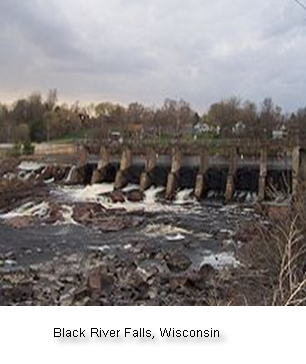
5.28 Miles
2.27 - 7.55
Cool-Cold Mainstem, Cool-Cold Headwater
2015
Poor
Elevated Water Temperature, Low DO
BOD, Sediment/Total Suspended Solids
Jackson
Yes
No
Yes
Fish and Aquatic Life
Overview
Even though Trout Run is listed in Wisconsin Trout Streams (WDNR), it is no longer considered a trout stream. Loss of in-stream habitat and possibly warmer water temperatures has changed Trout Run to a warm water forage fishery (Talley). The name of the stream implies that at one time, trout were present, if not abundant. Four drop structures to control water levels during storm events were constructed on Trout Run in the 1960s. Erosion is occurring immediately downstream of these structures (Olson). If Squaw Creek is selected as a small scale priority watershed project, Trout Run should be assessed for possible benefits before considering inclusion in the project.
From: Koperksi, Cindy. 1999. Black River Water Quality Management Plan (draft). Wisconsin Department of Natural Resources, Madison, WI.
Date 1999
Author Cynthia Koperski
Condition
Wisconsin has over 84,000 miles of streams, 15,000 lakes and milllions of acres of wetlands. Assessing the condition of this vast amount of water is challenging. The state's water monitoring program uses a media-based, cross-program approach to analyze water condition. An updated monitoring strategy (2015-2020) is now available. Compliance with Clean Water Act fishable, swimmable standards are located in the Executive Summary of Water Condition in 2018. See also the 'monitoring and projects' tab.
Reports
Management Goals
Wisconsin's Water Quality Standards provide qualitative and quantitative goals for waters that are protective of Fishable, Swimmable conditions [Learn more]. Waters that do not meet water quality standards are considered impaired and restoration actions are planned and carried out until the water is once again fishable and swimmable
Management goals can include creation or implementation of a Total Maximum Daily Load analysis, a Nine Key Element Plan, or other restoration work, education and outreach and more. If specific recommendations exist for this water, they will be displayed below online.
Monitoring
Monitoring the condition of a river, stream, or lake includes gathering physical, chemical, biological, and habitat data. Comprehensive studies often gather all these parameters in great detail, while lighter assessment events will involve sampling physical, chemical and biological data such as macroinvertebrates. Aquatic macroinvertebrates and fish communities integrate watershed or catchment condition, providing great insight into overall ecosystem health. Chemical and habitat parameters tell researchers more about human induced problems including contaminated runoff, point source dischargers, or habitat issues that foster or limit the potential of aquatic communities to thrive in a given area. Wisconsin's Water Monitoring Strategy was recenty updated.
Grants and Management Projects
| Project Name (Click for Details) | Year Started |
|---|
|
|
Monitoring Projects
| WBIC | Official Waterbody Name | Station ID | Station Name | Earliest Fieldwork Date | Latest Fieldwork Date | View Station | View Data |
|---|
| 1695500 | Trout Run | 10010229 | Trout Run - Trout Run Creek Station 3 | | | Map | Data |
| 1695500 | Trout Run | 10010227 | Trout Run Creek Station 4 | | | Map | Data |
| 1695500 | Trout Run | 10028998 | Trout Run Creek 131m ds CTH bridge | 1/1/2015 | 1/1/2015 | Map | Data |
| 1695500 | Trout Run | 10010226 | Trout Run - Trout Run Creek Station 5 | 1/1/2015 | 1/1/2015 | Map | Data |
| 1695500 | Trout Run | 10028997 | Trout Run Creek 130 m below confluence with East Branch | 1/1/2015 | 1/1/2015 | Map | Data |
| 1695500 | Trout Run | 10010231 | Trout Run Creek Station 1 | | | Map | Data |
|

Watershed Characteristics
Trout Run is located in the Trout Run and Robinson Creeks watershed which is 216.93 mi². Land use in the watershed is primarily forest (72.30%), agricultural (11%) and a mix of wetland (6.70%) and other uses (10.00%). This watershed has 326.05 stream miles, 791.85 lake acres and 17,562.31 wetland acres.
Nonpoint Source Characteristics
This watershed is ranked High for runoff impacts on streams, Not Available for runoff impacts on lakes and Low for runoff impacts on groundwater and therefore has an overall rank of Low. This value can be used in ranking the watershed or individual waterbodies for grant funding under state and county programs.However, all waters are affected by diffuse pollutant sources regardless of initial water quality. Applications for specific runoff projects under state or county grant programs may be pursued. For more information, go to surface water program grants.
Trout Run is considered a Cool-Cold Mainstem, Cool-Cold Headwater under the state's Natural Community Determinations.
Natural communities (stream and lake natural communities) represent model results and DNR staff valiation processes that confirm or update predicted conditions based on flow and temperature modeling from historic and current landscape features and related variables. Predicated flow and temperatures for waters are associated predicated fish assemblages (communities). Biologists evaluate the model results against current survey data to determine if the modeled results are corect and whether biological indicators show water quaity degradation. This analysis is a core component of the state's resource management framework. Wisconsin's Riverine Natural Communities.
Cool (Cold-Transition) Mainstem streams are moderate-to-large but still wadeable perennial streams with cold to cool summer temperatures. Coldwater fishes are common to uncommon, transitional fishes are abundant to common, and warm water fishes are uncommon to absent. Headwater species are common to absent,
mainstem species are abundant to common, and river species are common to absent.
Cool (Cold-Transition) Headwaters are small, usually perennial streams with cold to cool summer temperatures. Coldwater fishes are common to uncommon (<10 per 100 m), transitional fishes are abundant to common, and warm water fishes are uncommon to absent. Headwater species are abundant to common, mainstem species are common to absent, and river species are absent.